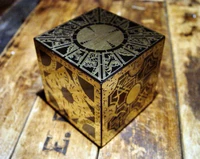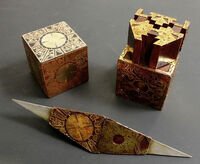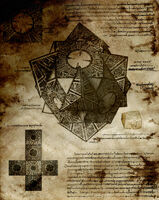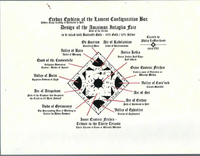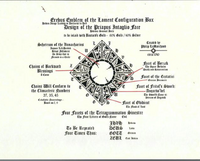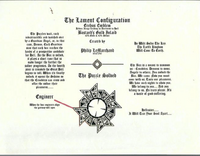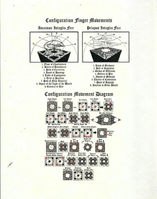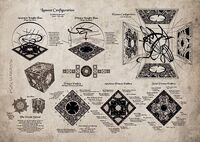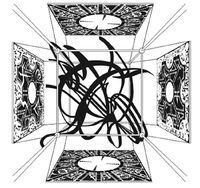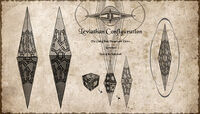- "The boxes, known in some circles as LeMarchand Boxes, were each one of a kind creations which were also puzzles, with the answer to one's ultimate heart's desire as their solution."
- — Excerpted from "Tucker's Encyclopedia of Mass Murderers".
A Puzzle Box or LeMarchand Box, is a fictional lock puzzle or puzzle box created by the fictional antagonist Philip LeMarchand, an 18th Century French architect, artisan and designer of some infamy. He first created his designs as bizarre, intricately designed music boxes, as he was well known as a maker of mechanical singing birds. But as a devotee of the occult, he became obsessed with the supernatural which directly influenced the creation of the first puzzle box, known as the 'Lament Configuration' or "The Box of Sorrows". When solved, a dolorous bell can be heard tolling, as if from a distance, announcing the arrival of the Cenobites, extra dimensional beings that serve the lord and master of Hell - Leviathan.
The Puzzle Box appears throughout the Hellraiser mythos, both in the books written by Clive Barker as well as other media formats.
Background[]
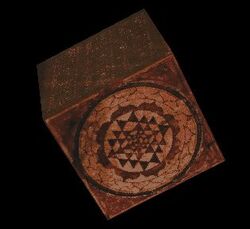
An ancient Sri Yantra - a hinduistic religious instrument said to have a life of its own - the basis in which LeMarchand would eventually use in the design of the 'Lament Configuration'.
The history of puzzle box hearkens back thousand of years. For as long as mankind has believed in the concept of a Heaven and a Hell, there are those who have actively sought the means to gain entrance into these realms, through any means. The keys to hell are so widely varied that they often take the appearance of a fantasy or fetish intended to lure a specific victim. The most common artefact for gaining access to the dimension of misery and pain is an unassuming device that takes the shape of a cube. Throughout history, the image of a cube is seen throughout the world's various cultures, whether it's the Yantra from the Tantric traditions of the Indian religion, the pop culture combination puzzle known as the Rubik's Cube or the idea of the Tesseract from the recent Avengers movies. Throughout the world, the image of a cube is a thing of power and is quite pertinent, especially in Kabbalistic and occultism. It is this last association of Philip LeMarchand's, the infamous architect, designer and artisan, who would create the notorious 'LeMarchand Boxes', masterfully constructed puzzle boxes that would become the embodiment of forbidden knowledge; a secret that could only be solved through obsession. For those who solved its secrets and placed its pieces in the final place, the puzzle would reveal something that wasn't evident before - the reality of Hell.
Lament Configuration[]
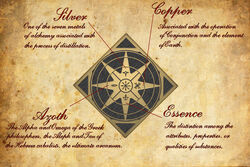
One of Reiss Kunst's sketches depicting a panel of the construct known as 'Coenobyte's Welcome'
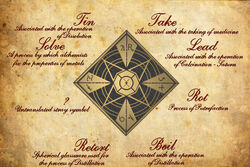
Another sketch of Reiss Kunst's work, depicting the material used in the creation of the 'Coenobyte's Welcome' cube.
LeMarchand's first puzzle box, the so-called 'Lament Configuration', was itself a bastardization of an original design of the famed 13th Century philosopher and theologian Albertus Magnus. LeMarchand's Box is only one of the puzzles as there are myriad more. As an avid scholar of the occult, LeMarchand had a fascination with artifacts of antiquity and it was no secret that he "borrowed" many of his designs from already infamous sources. But before LeMarchand could make his vision a reality, he first had to remove the obstacle of the unyielding properties of steel.
Philip LeMarchand was also a known member of the fraternal order of the Freemasons. Around 1743, while attending a Lodge meeting, he met the acquaintance of Frederick Braun, to whom he related his artistic difficulties. Monsieur Braun was gracious enough to lend LeMarchand a treatise on secret geometry. It was through this book that he learned of Reiss Kunst, a highly skilled master in the fields of astrology, mathematics, theology and sacred geometry. Accompanying the text were illustrations depicting geometric forms with curious titles such as 'Coenobyte's Welcome', and 'Spiral of Desperation'. The structures depicted by Kunst were ornate and complex, each a work of art not unlike the forms LeMarchand wished to create.
Kunst's work was inspired by puzzles crafted in the thirteenth century by Albertus Magnus which, when opened, introduced unknown wonders to the solver. He constructed his creations from a material which was previously unknown to him. This material was described as a dark polished stone, or lacquered wood, which felt like a warm, soft metal when touched, even though it was hard and possessed of no measurable radiant heat. LeMarchand vowed to do his best to learn more about these creations of both Kunst and Albertus Magnus and of the properties of the mysterious material they mentioned in their work.
Quest for Leviathan's Metal[]
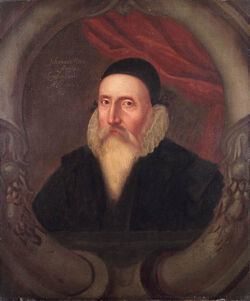
The Elizabethan magician John Dee.
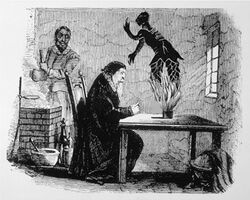
A woodcut depicting John Dee and his assistant Edward Kelley, summoning a 'Coenobyte' using a cube device similar to the works of Albertus Magnus.
Not long after, Philip LeMarchand would make the acquaintance of an Englishman, Geoffrey Chance, a collector of books, with many volumes of esoterica. Though LeMarchand was initially troubled by the occult content of many of the works, his apprehension became delight as he uncovered numerous references of Albertus Magnus and the "Coenobytes" within these works. He found references to the Coenobytes as far back as Saint Thomas Aquinas of the twelfth century. These beings, which LeMarchand first took for the peoples of a particular geographical region, were in fact beings of a supernatural order not unlike demons or angels. References to these beings came much more frequently, though with little further illumination, in the works of Agrippa and Giovani Pico della Mirandola.
The first significant reference appeared in a work on the Elizabethan Magus John Dee. According to the text, Barnabas Saul, who was Dee's first skryer, evoked the Coenobytes from their own realm and was told numerous secrets of a divine nature. When Bartholomew Hickman, Dee's final skryer, approached him concerning this, Saul denied it entirely. This text was accompanied by a woodcut of John Dee and Edward Kelley looking at a box like the one which was described by Reiss Kunst as being of the design of Albertus Magnus. This box appears to be admitting fire from which a Coenobyte is manifesting itself.
Another book described the journey of Livingston Merrick into Hell, after calling forth the Coenbytes through a magical formula of great antiquity. Upon the Coenbytes' arrival, Merrick offered to them his services. Livingston went forth with the Coenbytes into their own realm which he surmised was Hell. Here he found no inferno, but an oppressive labyrinth of cold stone. He also learned that it was not Satan who ruled this realm but a great rotating geometric form suspended in the air from which emitted beacons of black light. This form was in fact a being whose law was structure and order. This being was called Leviathan as was the great beast in the Bible. Livingston was in complete awe and fright, and was only spared his own life by offering to provide other beings to the Coenbytes in the future.

Portrait of Gilles de Rais - lieutenant to Joan of Arc, and infamous child killer.
LeMarchand dismissed these tales as nothing but fascinating fantasy, at best, but even in all fantasy he had found there were elements of both myth and reality. Furthering his research, LeMarchand later visited the chateau of Antoine de Moret and related to him his tales of artistic frustration. Monsieur de Moret produced a slender volume from his collection of books and from inside the book he removed several loose sheets of paper, which he explained were from the diary of Gilles de Rais. LeMarchand was no stranger to the legend of Gilles de Rais - lieutenant of Jeanne d'Arc, who was later executed for murdering over a hundred children as sacrifices to the devil. He had become something of a boogeyman to the children of France.
Leafing through these pages, LeMarchand learned that Gilles de Rais was not evoking devils, but a 'Cenobite', as it was spelled in this text, who called himself Baron. Gilles de Rais had first learned of the Cenobites through an Angevine knight in 1426 who was subsequently imprisoned, accused of heresy. Monsieur de Moret assured LeMarchand of the authenticity of the formula contained within the sheets of pager, now in his possession, were one in the same as the formula utilized by Gilles de Rais. Upon this revelation, LeMarchand was filled with intense anticipation. Monsieur de Moret then imparted one final gift to LeMarchand - the box of Albertus Magnus. LeMarchand purchases both the pages and the box at considerable cost, requiring that he offer his architectural services when he returned to New York.
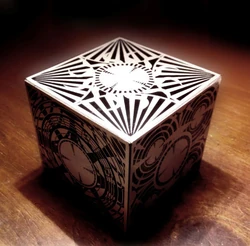
The original puzzle box crafted by Albertus Magnus, which became the basis of LeMarchand's puzzle box designs.
While sailing for New York, LeMarchand studied the box constructed by Albertus Magnus for much of the first night. After several hours of manipulating the tiny brass plates adorning the surface of the box, it began to move and shift. Finally tiny hatches, numbering nine on the face, opened to reveal tiny brass birds which joined to produce a delicate and beautiful harmony unlike any he had heard before. But through this melody, LeMarchand also heard the chiming of distant bells, and noted the scent of vanilla. This was when one of the cabin walls did open up, revealing a place other than the adjoining cabin; a dark and cold place, made of stone. He immediately recognized it for what it was - Hell, as described by Livingston Merrick. Out of this passage stepped a sort of man, of most gruesome appearance. His skin was nearly blue, and pulled taut across his skull, giving him a most dreadful grin. His cheeks were rouged, and he seemed heavily perfumed.
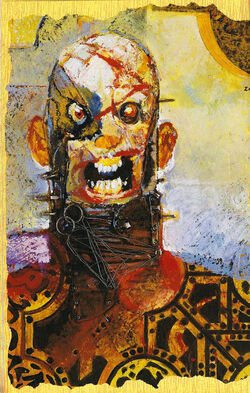
A sketch of the Cenobite called Baron, who imparted the secret knowledge of how to create the strange metal needed to construct LeMarchand's first puzzle box.
Though initially taken aback by his appearance, LeMarchand eventually found his voice and inquired whether or not the stranger was, in fact, a Cenobite. The creature replied that yes he was, and introduced himself as Baron, Duke of the Order of the Gash. It was the same Baron with whom Gilles de Rais had had dealings some three hundred years earlier. LeMarchand proceeded to explain his reason for contacting one of his Order, and described to the Cenobite the events leading to his attempts at evoking him, and his frustration and failures with steel as applied to his chosen art. LeMarchand produced for him several of his own sketches for the boxes which he had hoped to construct using this unknown material.
Appearing to be quite intrigued by the designs, Baron asked LeMarchand where did his inspiration come from? LeMarchand explained that they were constructs based on his own fascination with order and geometry. The Cenobite handed back LeMarchand his designs and related to him that, "you will serve us well." Baron then stepped forth into the adjacent hall as he opened the door to the seamen's quarters. LeMarchand asked what he was doing. The Cenobite replied that he could not return to Hell empty handed, and since LeMarchand would serve his master best by staying behind, he would have to procure another person to return in his place. LeMarchand looked on in horror as he swiftly dispatched one of the crew. Following his visit with the Cenobite, LeMarchand could not recalled the events that transpired after this meeting, but knew that this was merely the beginning of a long sequence of unsettling events which were to follow.
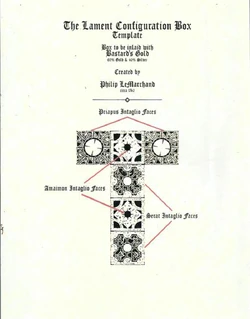
A schematic illustrated by LeMarchand, depicting his 'Lament Configuration' puzzle box.
At some point, during one of his invocations, the Cenobite Baron imparted the knowledge to LeMarchand of how to create the mysterious material needed to construct his puzzle box. This required the use of copious amounts of human fat. At this time, LeMarchand began killing innocent victims in order to obtain the necessary material needed in the construction of his first puzzle box. He began by murdering a local whore and his apprentice, Stephen, and boiling a mixture of their combined fat and other unknown ingredients. Boiling the macabre mixture for twenty four hours, he then tested the malleability of the material it had produced. The pasticity was not unlike that of lead or of a hard clay that required much kneading. LeMarchand also experimented with its resistance to tools, and found that it was extremely easy to work with. It seemed to share several of the same properties of steel, while being far more resilient, and easy to manipulate. Though the qualities of his puzzle box designs were extremely intricate, LeMarchand foresaw rapid progress in their execution now that he had finally acquired the means of creating 'bastard's gold'.
LeMarchand Boxes[]
With the help of the Cenobite Baron, LeMarchand successful constructed his first of many puzzle boxes known as the 'Lament Configuration' or the 'Box of Sorrows'. Following this initial success, he began to craft several more one of a kind creations - each being also puzzles - with the answers to one's ultimate heart's desire as their solution. Each box was unique for each person, a different puzzle requiring a different solution, a solution that was a ritual. It could never be easy to solve the box; it was something someone had to work at, and something someone had to want. LeMarchand Boxes quickly became the rage of Europe, but at the height of his career, Paris was besieged by scandalous multiple disappearances of noteworthy individuals, a number of whom had purchased LeMarchand's puzzle boxes.
It is believed that LeMarchand constructed more than 270 of his puzzle boxes before he vanished, murdering hundreds of people both across Europe and in America. These boxes changed hands rapidly, as is expected, though there were a few collectors, who were interested in the boxes as objects of admiration, and had no interest in working their wonders. By his 88th year, Philip LeMarchand had gone far beyond that first small puzzle. He had become one of hell's most prolific prodigies, eventually returning to his architectural education to design entire buildings that were puzzles in themselves. Scholars know from the completion dates of buildings ascribed to him that these building numbered about thirty, but the majority of these structures are believed to have been destroyed during the World Wars. Others met their ends in suspicious blazes, and in order to make room for newer buildings. LeMarchand's ultimate fate is unknown, for he disappeared at the age of 94 under mysterious circumstances, perhaps as a victim of his own creations.
Known Puzzle Box Configurations[]
- Lament Configuration - LeMarchand's first and arguably most classic, puzzle construct. Its complexity was managed by expanding on the design of a similar box designed and constructed by Albertus Magnus in the thirteenth century. This wondrous device possessed a minutiae of clockwork mechanisms and devices of resplendent symmetry. When operated properly, a pleasing melody issued from within which belied its true nature.
- The Triumph of Judas - This was the ninth box created by Philip LeMarchand though it was the second one he had conceptualized. He based its workings on the secret geometry contained in "The Last Supper" painting by Leonardo DaVinci. At this point it is believed he had murdered thirty-seven people.
- Love's Easy Tears - This was LeMarchand's tenth puzzle construct. The surface panels were designed to be manipulated in the same manner and order as the bones in Anna's body were removed by LeMarchand and the Cenobites following her rejection of LeMarchand's marriage proposal. It is said that working this box brings an intense feeling of depression to the manipulator. Some fifty-four people had now fallen victim to LeMarchand.
- The Hollow Heart - This fourteenth puzzle of LeMarchand's is activated by arranging the numerous surface plates in a manner similar to the arrangement of the streets of New York City in the time of its construction. Ninety-six people had now been murdered.
Other Puzzle Boxes[]
Barker's Hellraiser universe has on several occasions explored and demonstated the possibility of the existence of several other puzzle boxes.
- During the final chapter of The Hellbound Heart, after protagonist Kirsty Cotton has been given the Lemerchand's Box for safekeeping she is relieved after contemplating on the existence of puzzle boxes which can offer safe passage into paradise, rather then pain.
- Doctor Philip Channard, the main antagonist of the second hellraiser installment, Hellbound: Hellraiser II, is shown to have collected several puzzle boxes, all of which can be used to summon the Cenobites and are kept on display in the doctor's study. According to the film Hellraiser: Bloodline, these boxes are said to have been created by the demon princess Angelique sometime between the 18th and the 20th Centuries.
- The Host from the eighth installment, Hellraiser: Hellworld, is also a collector of puzzle boxes, here they are directly referred to as LeMarchand's Boxes. Only one of them is ever used in the entire film.
- Also of note, in Hellraiser: Bloodline, the Space Station Minos, from the year 2127, was built and piloted by Paul Merchant, a direct descendant of Philip LeMarchand. This space station is, in fact, the elusive Elysium Configuration, a giant LeMarchand's Box with the power to either destroy or permanently trap the Cenobites within their home dimension through the use of light. The Merchant Building from the 1990s, featured in both Hellraiser III and IV was designed by John Merchant (another descendant of Philip LeMarchand) and could also be used to transform into a giant LeMarchand Box.
Function & Restrictions[]
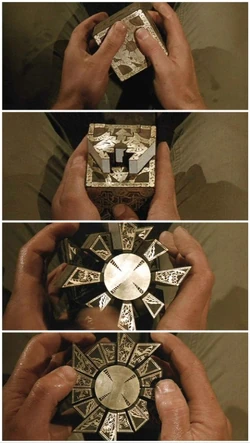
A depiction of the sequence of finger movements and manipulations of the Lament Configuration, as it takes on various forms.
A LeMarchand Box can be activated by pressing a series of hidden pressure points within a precise order. Very similar to a Chinese puzzle-lock box, the puzzle box changes shape in accordance to which button has been pressed. These shapes range from individual body parts removing themselves from the main body, to the entire bulk of the box gaining the shape of either a flower or even a lozenge (diamond). Operating the mechanisms behind the box requires the combined effort of both hands of the user, with every finger having to squeeze and/or scratch the box's surfaces. Solving the puzzle accurately can take hours of one's time, although this has not been the case during its appearance in the various Hellraiser films. After the puzzle has been completely solved the puzzle box will open up a portal to the Labyrinth. Within the Hellraiser universe this realm is a parallel dimension from which the Cenobites originate, as well as the home which they inhabit. This alternate plane of existence has been, on occasion, identified as the Hellraiser franchise's version of Hell.
In order to create a gateway to the Cenobites' home universe the Lament Configuration literally warps reality around itself. The first sequence activates the configuration's musical device, letting out beautiful sounds. Around the second and third sequences, the box opens up a small portal to the other world, just big enough, as the sounds of a large church bell can be heard as if from a distance. The bell's dolorous ringing signifies the imminent arrival of the Cenobites. Sometimes around the box, further disassembling itself, the portal begins engulfing the room around the recipient with pitch-black shadows, and one of the walls will start glowing with a bright blue shimmer. Once the bell has ceased ringing, the Cenobites make their appearance from the illuminated wall, the blue light obscuring their warped and twisted frames.
The effects of the Lament Configuration are loosely different during the various Hellraiser movies. While the box does in fact engulf the room in shadows and lets out an ominous bell toll, the blue light primarily emanates from the local doors and windows. Before the Cenobites can enter the human world, the gateways to the other world let out jolts of lightning and strong gusts of wind which break any item caught in their way. Probably the most notable difference between the novella and the movies is the manner through which the Cenobites appear. In the movies the Cenobites either spontaneously teleport via jolts of lightning, or walk through corridors opening up on the walls.
Emerging from their alternative home dimension, the Cenobites are tasked with escorting the recipient of the box back to the Labyrinth with them, in order to suffer an eternity of unimaginable torment. Shortly after the Cenobites' departure the Lament Configuration then restores the room to its former state, without leaving any clues as to the Cenobites' presence.
Restrictions & Loopholes[]
Aside from the standard function and usage of the Lament Configuration, this magical item can and has been utilized for other purposes:
- Aside from using the Lament Configuration to summon the Cenobites, it can also be used to teleport them back into their world by reversing the opening sequences. This power is exclusive to the movies and the comic books.
- Inside The Labyrinth the puzzle box is unable to teleport the Cenobites due to the fact that they already reside within their home dimension.
- The Lament Configuration can be reshaped by the Cenobites into the form of a lozenge (diamond), rendering it seemingly powerless. However, within this form the Configuration gains two new abilities. First, the lozenge can be reshaped back into its original box form by human hands. If this is done while the puzzle box is in the Labyrinth dimension, it subsequently reshapes Leviathan (the diamond-shaped deity that controls the Cenobites) into a giant puzzle box shape and releases countless souls trapped in the Labyrinth back into the human world. Secondly, it can be used as a stabbing weapon against the Cenobites (used only in Hellraiser III: Hell on Earth and the Hellraiser remake film).
- Just because a human has been taken away by the Cenobites doesn't mean they cannot return. If a recipient of the box should happen to bleed (ejaculate within the novella) while the box has been opened, then that sample will remain until someone else has bled over it, thus opening up a portal through which a skinless version of said recipient can return to the human world.
Inconsistencies[]
Even with the core concept and abilities of the Lament Configuration having been well defined, the properties involving the portal's conception retain a few minor inconsistencies. As follows:
- On some occasions, before the cenobites can make their appearance the box releases hook chains which grab onto the victim's flesh.
- During the events of the first Hellraiser film, Kirsty Cotton activates the portal to the Cenobites' home dimension, but instead of summoning the Cenobites, the box conjures up a hallway through which Kirsty can enter their world. Whether this is a random means of portal opening or an alternative activation of the puzzle remains unknown.
Keepers[]
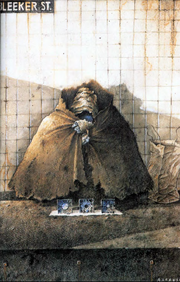
A "Keeper", guardian of the Puzzle Boxes.
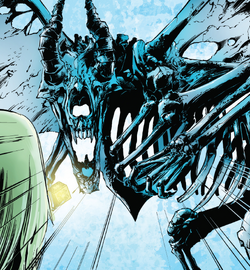
An Eremite transformed in it's demonic form, protecting a puzzle box.
The puzzles are never alone. Guarded by the Eremites or "Keepers," they are kept hidden, protected like secrets, treasures shrouded by shadow. Unlike the Cenobites, which are communal, Eremites are solitary. They serve Leviathan's will on Earth, solo. They're custodians of Hell's devices, passing on LeMarchand's toys onto new owners, and keep the puzzles safe from harm. Wrapped most often in human skin from the flesh vats of hell, these guardians roam free of detection. They manipulate, tantalize and enthrall, dealing the keys to hell like China-white heroin. They are Leviathan's grand masters of damnation game.
Wandering the fringes of our world, they follow trails scented by lust and desire. They can appear as anything they wish; a beggar on the street corner, a purring green-eyed cat that softly pads into your life on white-booted feet, or, if necessary, a creature you've seen only in your nightmares, lifting into the night sky on ghoulish tattered wings.
Often they have a home, a lair to which they can return and rest. They are usually dark and infested places hidden in sewers or under bridges, built like a rat's-nest, out of garbage. Amidst the clutter is their collection; trophies, mementos taken from their victims. Wallets, earrings, fingers, with photographs thumb-tacked to a wall beside newspaper clippings and milk carton pictures describing those who will remain forever "missing."
"What is your pleasure, sir?" Is the common phrase asked by a Keeper to those who seek the dark path to forbidden pleasure and pain. For those seeking something new, something dark, dangerous, something to put the edge back on their dulled life, they don't look long, for Hell will surely find them.
Further Reading[]
For further information please see the following topics:
Sources[]
- Hellraiser Companion: Book of the Damned #3
- Hellraiser (Epic Comics Series)
- The Hellbound Heart (Novella) by Clive Barker
- Hellraiser (Movie Franchise)





